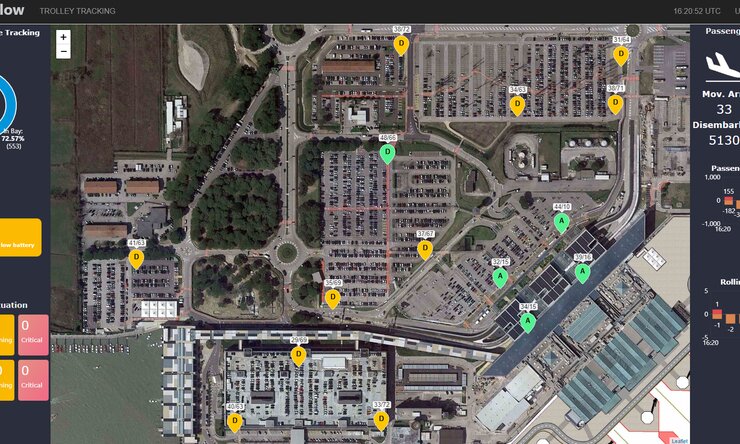The partnership between Wanzl and the Italian IT company NAITEC is revolutionising luggage trolley management at airports. With their combined expertise in luggage trolleys and tracking technology, they offer solutions that enable airports to efficiently manage and optimise their luggage trolley fleets. State-of-the-art camera technology and RFID for contactless data exchange makes it possible for information about the location, number and condition of luggage trolleys to be recorded. This ensures precise trolley tracking and monitoring in real time.
Wanzl and NAITEC's Trolley Tracking combines premium quality and long trolley service life with intelligent software. In this way, we are optimising processes at airports, facilitating significant cost savings and increasing passenger satisfaction. In addition, we are also demonstrating effective solutions with regard to the acute staff shortages at airports – and these solutions can be expanded with the use of modules at any time," explains Michael Tscharntke, Project Manager who is also responsible for airport tracking at Wanzl. Alberto Torresan, Chief Operating Officer at NAITEC adds: "We offer a complete solution that includes the hardware for the Trolley Tracking and the software as an SAAS* model for monitoring. This perfectly complements our expertise."
Individual tracking solutions for all airports
Wanzl luggage trolleys are extremely robust and durable in daily use. The TrolleyFlow software, specially developed for airport use, ensures accurate digital tracking of luggage trolleys and makes sure that they are available for use exactly where they are needed. This saves time and resources. The Trolley Tracking system ensures that airports always have enough luggage trolleys available for guests. As a trustworthy partner with experience and expertise in the airport sector, Wanzl Airport and NAITEC offer tailor-made solutions to meet the individual requirements of large airports, airports with limited space and terminal operators. The tracking software can be seamlessly integrated into existing infrastructures such as the airport operational database (AODB) and baggage handling system (BHS) and allows for easy expansion of the system.
Davide Bassano, Director of Sustainability at Venice Airport, has also confirmed the success of the Trolley Tracking system after retrofitting Wanzl luggage trolleys with the Trolley Tracker: "The main problem we wanted to solve with the introduction of the Trolley Tracking system was to improve process and service efficiency. Venice Airport has limited space and we couldn't just increase the number of luggage trolleys. This would have incurred high operating costs. It was therefore clear to us that we needed to improve the efficiency of the process". He adds: "We chose the Wanzl and NAITEC Trolley Tracking system because it is the only way to capture information in real time about where the trolleys are, where they are needed and where they need to be sent to. This allows us to provide our airport guests with a pleasant stay and save on process time. For us, this means improving service while maintaining the cost level."
Tailored tracking for optimum efficiency
The partnership between NAITEC and Wanzl Airport now offers customers a one-stop-shop solution: comprehensive support from consulting and project management through to production as well as testing and commissioning. The Wanzl team takes care of the implementation and trains staff in how to use the system. NAITEC provides the tracking software and hardware and takes care of remote maintenance. Depending on the customer’s wishes and requirements, there are various modules that can be combined with each other or subsequently expanded: The range of services includes cloud-based software maintenance, the counting of luggage trolleys at specified depots or especially at entrances, exits or transition points.
Either computer vision cameras, passive RFID tags or Bluetooth Low Energy (BLE) devices are used here. Existing cameras can of course also be used for this purpose. The “luggage trolley locations” module uses defined zones to determine where passengers leave their trolleys – both inside and outside the airport. Efficient staff management and optimal luggage trolley use can be easily planned by real-time data transmission. Sensors in the ground send data to the cloud for processing and storage. The dashboard resembles a modern website and displays all the data clearly. Those who need dynamic predictions of trolley requirements, i.e. who want to proactively know when and how many luggage trolleys need to be provided where, are best served with TrolleyFlow.
